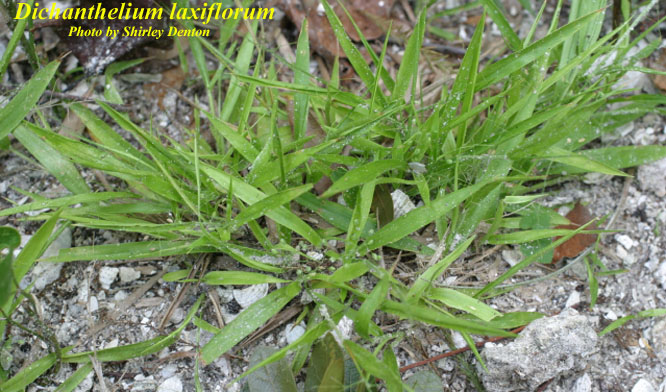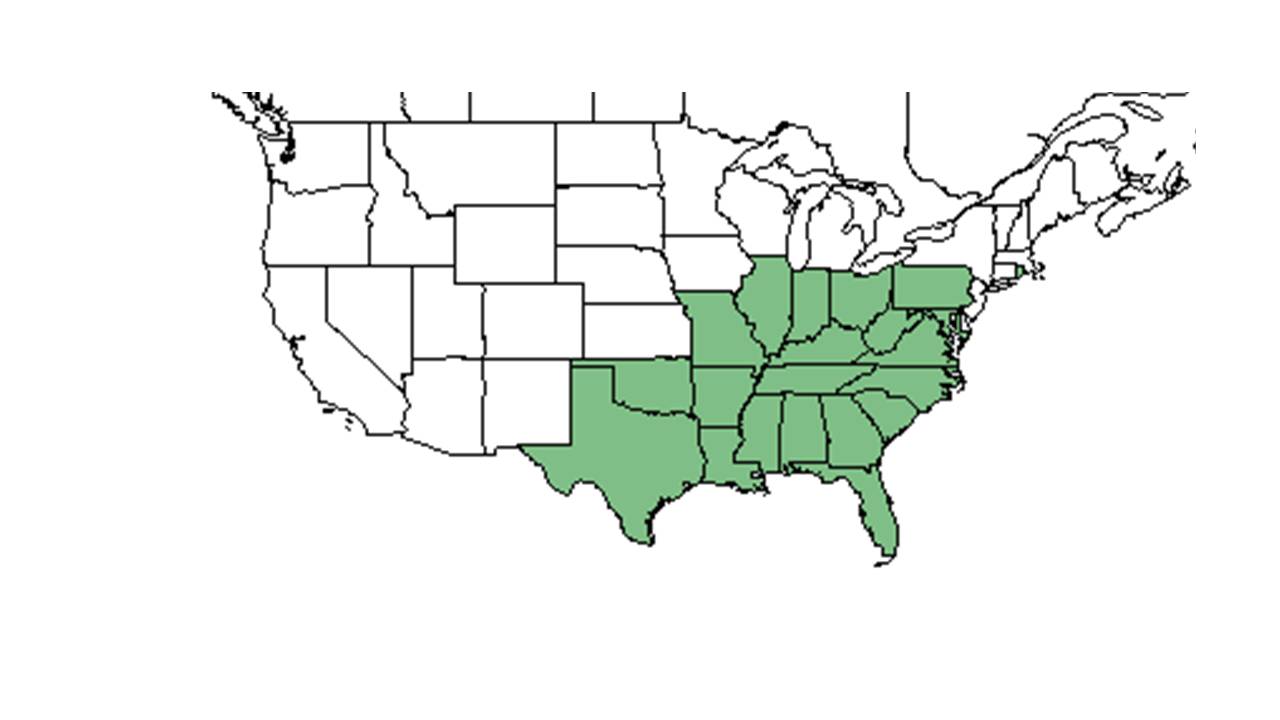Difference between revisions of "Dichanthelium laxiflorum"
| Line 3: | Line 3: | ||
{{taxobox | {{taxobox | ||
| name = Dichanthelium laxiflorum | | name = Dichanthelium laxiflorum | ||
| − | | image = | + | | image = Dich_laxi.jpg |
| − | | image_caption = | + | | image_caption = Photo by Shirley Denton, [http://www.florida.plantatlas.usf.edu/ Atlas of Florida Vascular Plants] |
| regnum = Plantae | | regnum = Plantae | ||
| divisio = Magnoliophyta - Flowering plants | | divisio = Magnoliophyta - Flowering plants | ||
Revision as of 16:12, 10 November 2015
| Dichanthelium laxiflorum | |
|---|---|

| |
| Photo by Shirley Denton, Atlas of Florida Vascular Plants | |
| Scientific classification | |
| Kingdom: | Plantae |
| Division: | Magnoliophyta - Flowering plants |
| Class: | Liliopsida – Monocotyledons |
| Order: | Cyperales |
| Family: | Poaceae ⁄ Gramineae |
| Genus: | Dichanthelium |
| Species: | D. laxiflorum |
| Binomial name | |
| Dichanthelium laxiflorum (Lam.) Gould | |

| |
| Natural range of Dichanthelium laxiflorum from USDA NRCS Plants Database. | |
Common name: openflower rosette grass
Synonym: Panicum laxiflorum Lam.
Contents
Taxonomic notes
Description
Dichanthelium laxiflorum is a perennial graminoid with a cespitose growth habit (FSU Herbarium).
Distribution
Ecology
Habitat
D. laxiflorum can live in disturbed areas such as clear-cuts, thinned woods, burned areas, roadsides, power line corridors, and old fields (FSU Herbarium), with clay to sandy loam soil in subtropical climates.[1] It can also dwell in dry areas,[2] like sandstone barrens communities.[2] It can be found in loblolly pine communities[3] and longleaf pine communities.[4] It also occurs in low ground hardwood communities, mesic hammocks, river banks, above lime sinks, on coastal hammocks, and near bogs (FSU Herbarium).
Associated species include Senecio, Krigia, Lolium, Hordeum, Tradescantia, Scleria, Diospyros, Rhus copallina, Hypericum mutilum, P. angustfolium, D. commutatum (FSU Herbarium).
Phenology
Flowering has been observed in January through May, and November, and fruiting has been observed in January through June, and November (FSU Herbarium).
Seed dispersal
It can be found in the seed bank of disturbed and undisturbed sites.[4] It can also be found in the seed bank of a Florida flatwoods plant community.[5]
Seed bank and germination
From observing the results of Taft's prescribed burns, fire seems to be required for germination.[2]
Fire ecology
This species has been found in frequently burned areas (FSU Herbarium).
In an experiment by Iglay, Leopold, Miller, and Burger, D. laxiflorum had a positive response to dormant season prescribed fire and to imazapyr, a herbicide.[1] Following an early dormant season, moderate-intensity burn in 1989, it rapidly increased, probably due to a stimulation if the seed bank. By 1995, D. laxiflorum occurred in 64% of the quadrants in Illinois and was the species with the greatest frequency, replacing Schizachyrium scoparium as the dominant species.[2]
Pollination
Use by animals
Diseases and parasites
Conservation and Management
Cultivation and restoration
Photo Gallery
References and notes
Florida State University Robert K. Godfrey Herbarium database. URL: http://herbarium.bio.fsu.edu. Last accessed: June 2014. Collectors: Loran C. Anderson, Bonnie Carswell, Kurt E. Blum, Sidney McDaniel, Lloyd H. Shinners, R. F. Thorne, R. A. Davidson, R. Kral, Raymond Athey, John B. Nelson, S. Bennett, T. Kohlsaat, D. Kennemore, Charles N. Horn, Carolyn Kindell, W ledbetter, R.K. Godfrey, K. Craddock Burks, J. B. Phipps, Sydney Thompson, R. F. Thorne, R. A. Davidson, A. H. Curtiss, Sidney McDaniel, James R. Burkhalter, Patricia Elliot, C. Jackson, H. Kurz, George R. Cooley, Joseph Monachino, R. Komarek, Cecil R Slaughter, Marie Victorin, Rolland Germain, Marcel Raymond, J. Kucyniak, and André. States and Counties: Alabama: Geneva and Pickens. Florida: Alachua, Calhoun, Franklin, Gadsden, Hernando, Holmes, Jackson, Jefferson, Lee, Leon, Levy, Liberty, Madison, Nassau, Palm Beach, Putnam, Santa Rosa, Taylor, Union, Walton, and Wakulla. Georgia: Decatur and Grady. Kentucky: Carlisle. Louisiana: East Feliciana. North Carolina: Wake. South Carolina: Abbeville, Fairfield, and Calhoun. Tennessee: Coffee. Texas: Freestone and Van Zandt. Other Countries: Canada
- ↑ 1.0 1.1 Iglay, R. B., B. D. Leopold, et al. (2010). "Effect of plant community composition on plant response to fire and herbicide treatments." Forest Ecology and Management 260: 543-548.
- ↑ 2.0 2.1 2.2 2.3 Taft, J. B. (2003). "Fire effects on community structure, composition, and diversity in a dry sandstone barrens." Journal of the Torrey Botanical Society 130: 170-192.
- ↑ Miller, J. H. and K. V. Miller (1999). Forest plants of the southeast, and their wildlife uses Champaign, IL, Southern Weed Science Society.
- ↑ 4.0 4.1 Cohen, S., R. Braham, et al. (2004). "Seed bank viability in disturbed longleaf pine sites." Restoration Ecology 12: 503-515.
- ↑ Kalmbacher, R., N. Cellinese, et al. (2005). "Seeds obtained by vacuuming the soil surface after fire compared with soil seedbank in a flatwoods plant community." Native Plants Journal 6: 233-241.